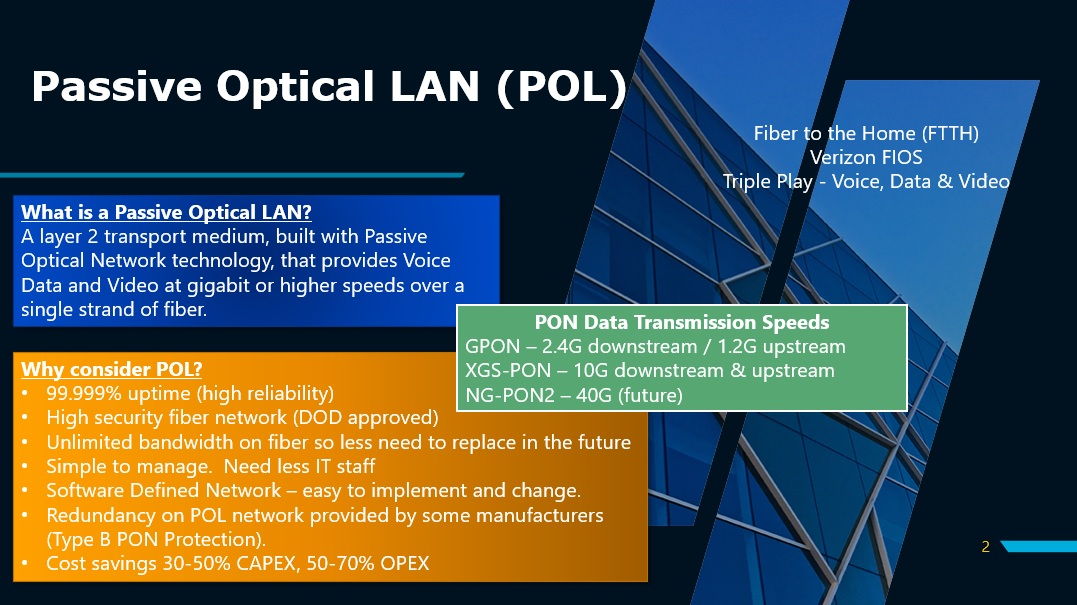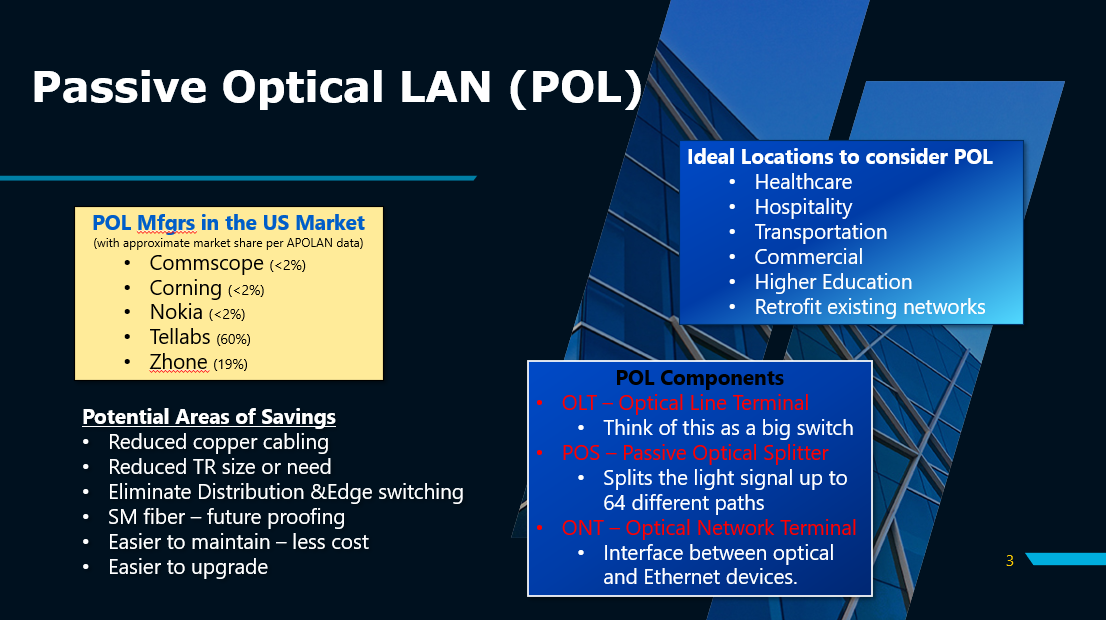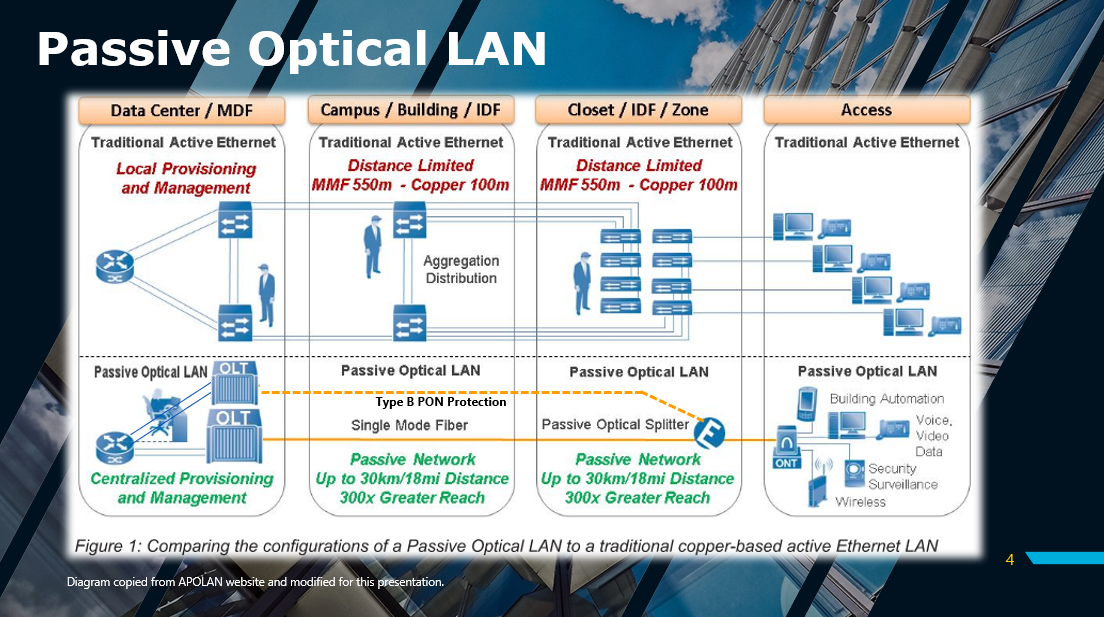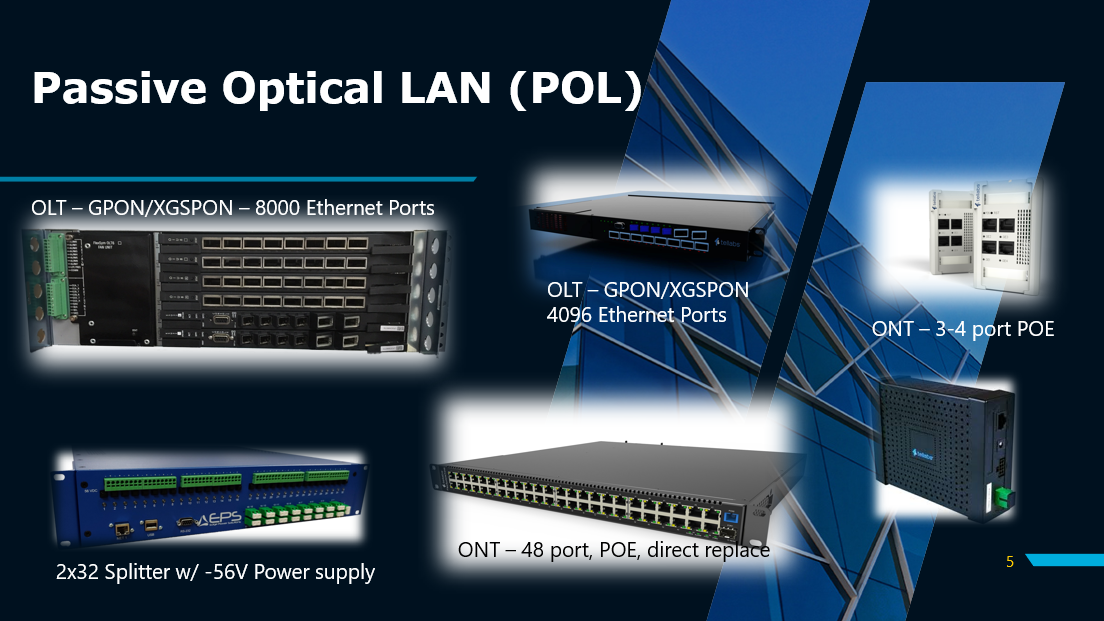passive optical network (pon)
What is a Passive Optical LAN?
So, what is a Passive Optical LAN, also called a Passive Optical Network (PON)? A PON is a layer 2 transport medium built on a single mode fiber optic network. A PON uses specialized optical network technology developed by the Bell phone companies years ago. Verizon FIOS is a great example of a PON system providing voice, data and video to customers across the country.
Current PON technology known as GPON or Gigabit Passive Optical Network can provide up to 2.4G downstream and 1.2G upstream to thousands of end users on one single network. XGSPON provides 10G upstream and downstream bandwidth. PON technologies are currently in development to provide 40 and 100G of bandwidth!
Why should you consider PON for your next project?
PON systems are extremely reliable. Built for the phone industry they achieve 5-9's reliability right out of the box. PON systems use high security 128 bit encryption. There is no known bandwidth limit on single mode fiber which means the physical plant will be ready for use for years to come. Redundancy on the PON network can be provided to increase system reliability even beyond 5-9's where needed.
Last but not least, studies have shown significant capital and operational cost savings over the life of the system. Owners achieving 30-50% CAPEX and 50-70% OPEX savings have been documented.
Current PON technology known as GPON or Gigabit Passive Optical Network can provide up to 2.4G downstream and 1.2G upstream to thousands of end users on one single network. XGSPON provides 10G upstream and downstream bandwidth. PON technologies are currently in development to provide 40 and 100G of bandwidth!
Why should you consider PON for your next project?
PON systems are extremely reliable. Built for the phone industry they achieve 5-9's reliability right out of the box. PON systems use high security 128 bit encryption. There is no known bandwidth limit on single mode fiber which means the physical plant will be ready for use for years to come. Redundancy on the PON network can be provided to increase system reliability even beyond 5-9's where needed.
Last but not least, studies have shown significant capital and operational cost savings over the life of the system. Owners achieving 30-50% CAPEX and 50-70% OPEX savings have been documented.
Is PON the right solution for me?
There are several manufacturers who sell PON equipment worldwide. There are fewer still that actually engineer and manufacture their products. In the US Market Tellabs and Zhone are the two leaders. As of 2018 Tellabs held about 60% of the US market and Zhone about 19%.
PON is an ideal technology to consider in most any vertical market. Some PON manufacturers are DOD certified for government installations. Actually one of the largest PON installations is a government facility in the western United States with over 85,000 ethernet ports connected!
There are three main components in a PON system. The OLT is the headend or brains of the system. The ONT is the end device which connects fiber optic cables to your computers, phones, cameras and wifi access points. The third device is the passive optical splitter which sits in the middle of the network and splits the light signal between multiple ONTs.
There are many potential areas of savings with a PON system. For example there is much less copper cabling required which not only reduces cost but is more environmentally friendly. Telecom rooms can be reduced giving valuable floor space back for other uses. Distribution and Edge switching can be eliminated. Single mode fiber has unlimited bandwidth so the fiber you install today will still be viable for many years to come.
PON is an ideal technology to consider in most any vertical market. Some PON manufacturers are DOD certified for government installations. Actually one of the largest PON installations is a government facility in the western United States with over 85,000 ethernet ports connected!
There are three main components in a PON system. The OLT is the headend or brains of the system. The ONT is the end device which connects fiber optic cables to your computers, phones, cameras and wifi access points. The third device is the passive optical splitter which sits in the middle of the network and splits the light signal between multiple ONTs.
There are many potential areas of savings with a PON system. For example there is much less copper cabling required which not only reduces cost but is more environmentally friendly. Telecom rooms can be reduced giving valuable floor space back for other uses. Distribution and Edge switching can be eliminated. Single mode fiber has unlimited bandwidth so the fiber you install today will still be viable for many years to come.
What does a PON network look like?
In the diagram, across the top is what a typical copper/fiber network might look like. On the left is the Data Center or MDF, this where the core network equipment resides. From here usually multimode or singlemode fiber is run to the middle layers. In the middle you may have a campus or distribution layer and then a closet or IDF zone where edge switches are located. From here copper cabling is run up to 300 feet to the end devices at the access layer.
The Passive Optical Network (shown in the lower half) starts out the same in the data center with your core equipment such as routers, firewalls and core switches. The OLT resides at this level and is the headend for the PON system. From the OLT out to the ONT there is no active equipment required. Only passive splitters and optionally redundant power maybe provided in the IDF zone. The ONT is pushed all the way to the Access layer where it is connected via short copper cables to the end devices.
Type B PON protection can be added with redundant fiber by some manufacturers to improve system reliability when that is required.
The Passive Optical Network (shown in the lower half) starts out the same in the data center with your core equipment such as routers, firewalls and core switches. The OLT resides at this level and is the headend for the PON system. From the OLT out to the ONT there is no active equipment required. Only passive splitters and optionally redundant power maybe provided in the IDF zone. The ONT is pushed all the way to the Access layer where it is connected via short copper cables to the end devices.
Type B PON protection can be added with redundant fiber by some manufacturers to improve system reliability when that is required.
Typical PON Equipment
The OLT or Optical Line Terminal is the heart of the PON system. The two models shown can provide both GPON and XGSPON on the same fiber network. The larger OLT can handle up to 8000 ethernet ports and the smaller more economical model can provide over 4000 ethernet ports on one network.
The 48 port, POE ONT in the middle is a great option for direct switch replacement where you want to upgrade an aging traditional network with the features of a PON network and keep your investment in copper and fiber cabling.
The 2x32 splitter is a great way to provide remote power and fiber to multiple ONTs from a remote central location. This way power can be backed up and managed for example in a condo or retail facility where tenant management is required.
ONT's come in several configurations. Some are wall mounted, some are designed to sit on or be mounted under a desk. Smaller ONT's typically have from 3 to 8 ethernet ports and some have POTS lines and coaxial tv connections.
The 48 port, POE ONT in the middle is a great option for direct switch replacement where you want to upgrade an aging traditional network with the features of a PON network and keep your investment in copper and fiber cabling.
The 2x32 splitter is a great way to provide remote power and fiber to multiple ONTs from a remote central location. This way power can be backed up and managed for example in a condo or retail facility where tenant management is required.
ONT's come in several configurations. Some are wall mounted, some are designed to sit on or be mounted under a desk. Smaller ONT's typically have from 3 to 8 ethernet ports and some have POTS lines and coaxial tv connections.
CONTACT
Want to know more? Give us a call or send an email, we will be happy to discuss your project.
(o) 804-427-6540
(c) 804-519-7565
(c) 804-519-7565
©2020 - redbrick technology group, llc





